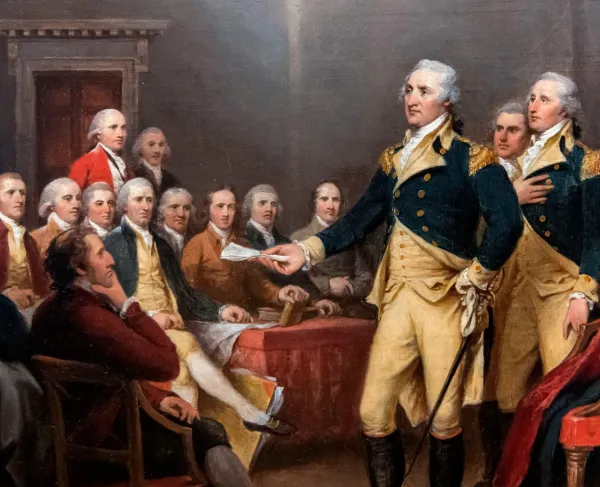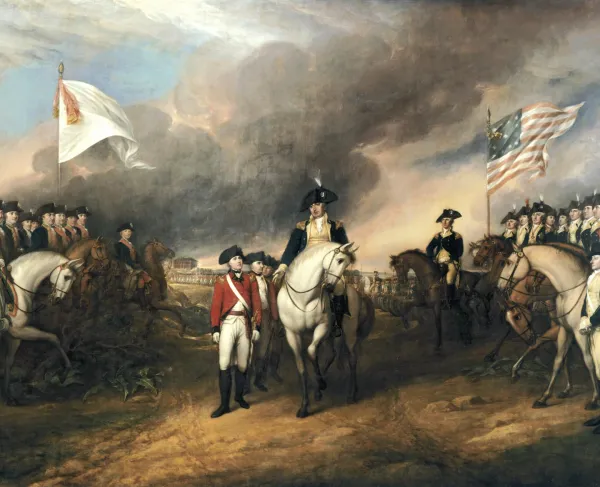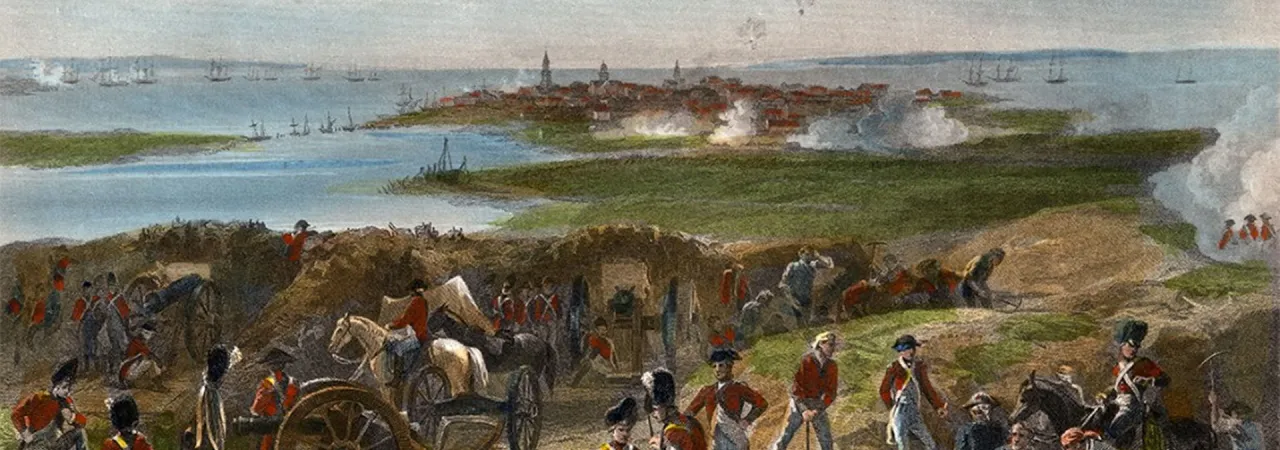
A depiction of the Siege of Charleston (1780) by Alonzo Chappel.
Fact #1: Charleston was known as Charles Town during the Revolutionary War.
After King Charles II chartered the Province of Carolina in 1663, settlers from Barbados and Bermuda began to arrive to colonize the region. The settlers established a city at Albemarle Point, a few miles northwest of the present-day city center on the west bank of the Ashley River. They named the city “Charles Town” in honor of their sovereign and the colony’s founder. By 1719, colonists began to write the city’s name as Charlestown. This variation grew in popularity, and the city was known as "Charlestown" throughout most of the eighteenth century. In 1783, just before the war ended with the Treaty of Paris, Charlestown’s rapid growth necessitated a municipal government. On August 13 an act of incorporation for the city provided the citizens an opportunity to change its name. They shortened it to “Charles Ton.” In the years succeeding the city’s incorporation, the spelling “Charleston” achieved widespread prominence and is now the city's official name.
Fact #2: Before the war, Charleston was the wealthiest city in the thirteen colonies and the scene of unrest.
By the mid-eighteenth century, the plantations of South Carolina fostered a thriving economy in Charleston. The city boasted the largest population in the southern colonies, with 11,000 residents in 1770. By this time, Charleston was the hub of the Atlantic slave trade in the colonies—with slaves constituting about half of the city’s population. Until the end of the slave trade, Charleston’s customs processed about 40 percent of the African slaves brought to North America. Because of its prosperity, Charleston quickly became a contested city for the French and Spanish as well as a target for piracy. The infamous pirate Blackbeard laid siege to the city in 1718. Slave revolts and uprisings occurred in the years preceding the Revolution, including the Stono Rebellion, in which 25 whites and about 35 to 50 Blacks were killed.
Fact #3: Charleston had its own “tea party” in 1773, predating the Boston Tea Party.
After the revocation of the Townshend Act in 1770, the British Parliament maintained the tea tax in order to uphold its right to levy taxes on the colonies. Though Parliament intended the policy to pay off the debt incurred by the British East India Company, Americans met the Tea Act with outrage. Colonists protested in many ports by leaving the shipment of East India Company tea unloaded on the docks. In December 1773, an East India Company ship named the London sailed into Charleston carrying 257 chests of tea. In the weeks leading up the London’s arrival, a group of Charleston’s citizens decided to protest the Tea Act by taking a shipment to the Old Exchange building—nine days before the Boston Tea Party. The tea was not removed from the building until 1776, when it was sold to help fund the war for independence. Two more tea parties occurred in Charleston in 1774: the first of which resembled the events of the protest in 1773, and the second bore a closer resemblance to the Boston Tea Party as citizens dumped the tea into Charleston Harbor.
Fact #4: Fort Moultrie on Sullivan’s Island was built from palmetto logs during the Revolutionary War and inspired South Carolina’s state flag and nickname “The Palmetto State.”
First known as Fort Sullivan, Fort Moultrie was built by South Carolina patriots to guard Charleston Harbor in early 1776. On June 28, nine British warships arrived in the harbor and bombarded Fort Sullivan, which was still under partial construction. Colonel William Moultrie, commanding the Patriot garrison of Fort Sullivan, could only bring twelve guns to bear on the British fleet's locations due to limited supplies and range. However, the fort's palmetto logs proved resilient, as the British cannonballs reportedly bounced off the structure's walls. The country hailed Colonel Moultrie as a hero, and the South Carolina General Assembly renamed the fortification "Fort Moultrie" in honor of its commander in the Battle of Sullivan's Island. South Carolina later represented the story of Fort Moultrie on its state flag with the palmetto tree, drawing inspiration from Colonel Moultrie’s flag flown during the battle.
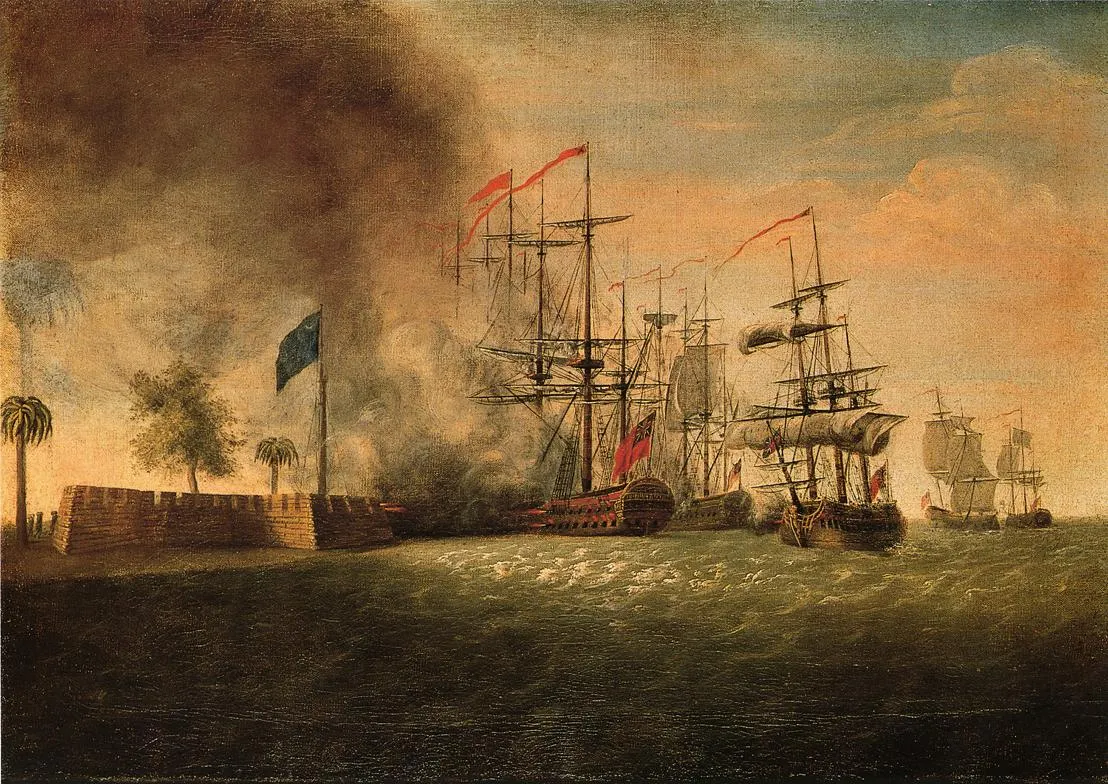
Fact #5: The British laid siege to Charleston in 1780, which compelled American forces to surrender the city.
After failed offensives in New England and the Middle Colonies, the British shifted their attention to the Southern Colonies. In February 1780, the British fleet anchored on the Savannah River, and General Sir Henry Clinton marched an army within 30 miles of Charleston. Between March 29 and May 12, Clinton cut off the city’s supplies and denied a request by American commander Benjamin Lincoln to negotiate. Lincoln offered to surrender if his men were allowed to leave unharmed, but Clinton insisted on unconditional terms. British warships successfully passed the guns of Fort Moultrie in Charleston Harbor, which further isolated Lincoln’s position and closed off any means of escape. Over the next two weeks, the British moved to within a few yards from the American defenses. After Benjamin Lincoln refused Clinton’s demands for an unconditional surrender, the British general ordered a bombardment of Charleston. With Charleston in flames, Lincoln finally ended the siege by surrendering his army of 5,000 men on May 12, 1780. It was the largest surrender of American forces until the Siege of Harper's Ferry in September of 1862.
Fact #6: One of the most prominent British executions of an American during the Revolution occurred in Charleston in 1781.
By 1780, the British invasion of South Carolina compelled Patriot forces in Charleston to surrender. Captain Isaac Hayne, a member of the Colleton County militia, was among those who surrendered when the British took Charleston. The British authorities demanded Hayne and all others paroled on the same terms to join the British Army or take an oath of allegiance to the Crown. However, smallpox struck his family and forced Hayne to seek medical help in Charleston. The British assured Hayne that he would not be required to take up arms against his fellow Americans in the name of the Crown. Therefore, Hayne took the oath of allegiance. By 1781, as British fortunes faded, Hayne was summoned to fight for the King. Believing the British had violated his agreement—and following the death of his wife and two daughters to smallpox—Hayne fled for the Continental Army. He was commissioned a local militia colonel and participated in an American raid during which he was captured. The British condemned him to death for allegedly breaking his oath to the crown. Isaac Hayne was hanged on August 4, 1781, and interred in his family plot in Jacksonborough according to his wishes. Though the British desired to make an example of Hayne, the people of Charleston hailed the young patriot as a martyr to the American cause.
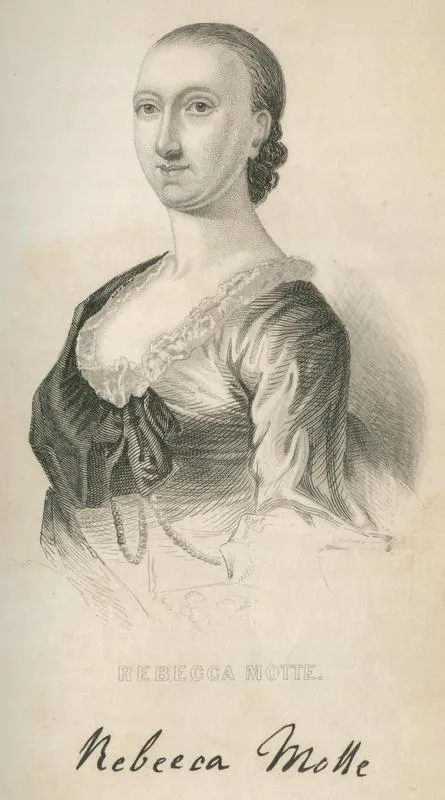
Fact #7: The British established a fort at a Charleston family’s home in 1781.
Situated on the western banks of the Congaree River, the Mount Joseph Plantation attracted the eye of Charleston’s British invaders for its access to the waterways connecting Charleston to the Carolina backcountry. Owned by wealthy slave trader Miles Brewton, the plantation fell to the ownership of his sister Rebecca Brewton Motte after his death at sea. After her husband Jacob Motte died of illness in 1780 while serving in the Continental Army, Rebecca took her family from their home in Charleston to the plantation after the siege. However, Rebecca and her children could not escape their enemy for long. British troops arrived on the plantation in January 1781 and used the home as their headquarters and a supply depot during their occupation of Charleston. The Motte family resided in an old farmhouse while British regulars garrisoned the mansion—earning it the moniker Fort Motte. The fort soon fell victim to an American attack under the joint command of Lieutenant Colonel Henry Lee and Brigadier General Francis Marion. On May 8, 1781, the Americans laid siege. After the British refused to surrender, one of the American commanders asked Rebecca Motte if they could burn down her home to destroy the supply depot. A loyal devotee to the American cause, Rebecca agreed. The Americans set fire to the house, but Marion issued orders to help extinguish the fire after the British surrendered. The Motte family never again occupied the mansion at Mount Joseph Plantation.
Fact #8: Although the British captured Charleston, guerrillas like Francis Marion continued the fighting around the city.
Following the American defeat at Charleston and the city’s subsequent capture, the British army remained largely uncontested in the Southern Colonies. Francis Marion’s small band of twenty to seventy men stood as the only force opposing the British offensive in the region around Charleston. Marion, along with Wade Hampton I, waged guerilla war on the King’s troops in South Carolina as well as conducted raids into Charleston. In November 1780, British leadership dispatched Colonel Banastre Tarleton to capture or kill Marion. After pursuing Marion's troops for over 26 miles through a swamp, Tarleton allegedly said, "as for this old fox, the Devil himself could not catch him," in reference to the elusive American guerilla. Marion's followers took a liking to the name and began to call him "the Swamp Fox."

Fact #9: British forces liberated thousands of slaves during their occupation of Charleston.
Almost a year before the British capture of Charleston, General Sir Henry Clinton issued the Philipsburg Proclamation, encouraging slaves to flee and enlist in the British Army. Throughout the war, nearly 25,000 slaves in South Carolina fled, migrated, or died—constituting about 30% of the state’s enslaved population. With the British occupation of Charleston in 1780, black Loyalists raised two regiments to garrison the city. With an impending Patriot victory, over 5,000 blacks evacuated Charleston with the British and loyalists in 1782. Though most of these people were slaves owned by loyalists and continued their lives in bondage, some blacks achieved their freedom by fleeing patriot owners for British lines. These freed slaves evacuated Charleston with the British and settled in places like Canada, the Caribbean, and a freeman’s colony in Sierra Leone.
Fact #10: December 14, 1782, is known as Victory Day in Charleston—commemorating the evacuation of British forces from the city.
Even as the Franco-American Army defeated Lord Charles Cornwallis at Yorktown in 1781, the Revolutionary War persisted. During this time, the British firmly held Charleston. Following the pyrrhic British victory at Guilford Courthouse, General Nathanael Greene retained an American presence in South Carolina to contest the King’s army if they launched an offensive. However, the commander of the British garrison at Charleston, Major General Alexander Leslie, requested a truce with American forces in March 1782 to purchase food for his men and residents of the town. Greene refused, and British, Hessian, and Loyalist troops evacuated Charleston on December 14. Continental soldiers escorted their foes out of the city and onto boats awaiting their departure in Charleston Harbor. The evacuation of Charleston—and other strongholds like New York and Savannah—marked the end of British occupation in the new United States.
Related Battles
5,506
258
37
220
